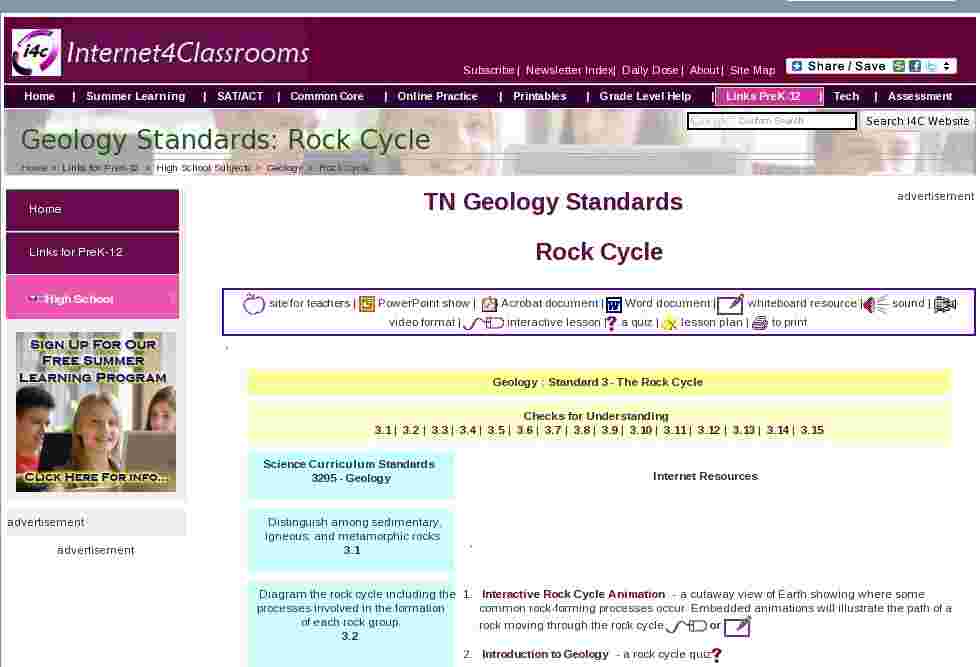TN Geology Standards
Rock Cycle
site for teachers |
PowerPoint show |
Acrobat document |
Word document |
whiteboard resource |
sound |
video format |
interactive lesson |
a quiz |
lesson plan |
to print
Science Curriculum Standards
3205 - GeologyDistinguish among sedimentary, igneous, and metamorphic rocks.
3.1
- Interactive Rock Cycle Animation - a cutaway view of Earth showing where some common rock-forming processes occur. Embedded animations will illustrate the path of a rock moving through the rock cycle.
or
- Introduction to Geology - a rock cycle quiz
- The Rock Cycle - Look at the diagram and see if you can trace a rock through the rock cycle.
- Rock Cycle from the Mineralogical Society of America
- Rock Cycle - a review lesson followed by a quiz [from McGraw Hill]
and
- Rock Cycle - a drag and drop quiz
or
- Rock Cycle Diagram - an Interactive site from Annenberg
- Rock Cycle Quiz - twenty multiple-choice questions, all on the same page
- Rock Cycle Quiz - nine multiple-choice questions, each on a separate page
- Rock Cycle Quiz - from Vision Learning - ten multiple-choice questions, some with accompanying photos
- Rock Cycle Quiz - ten definitions are given, you pick the correct term - multiple-choice format
- Rock Cycle Quizzes - there are three rock cycle quizzes at this site
- Rocky's Rock Cycle Games - Easy - Harder - drag the pictures into the correct place on the rock cycle drawing - from the Oxford University Museum of Natural History
or
- A Schematic Sketch of the Rock Cycle - boxes represent earth materials and arrows represent the processes that transform those materials
- Animation of clastic sedimentary rocks forming - Use the movie controls to examine each part of the sequence
or
- Animation of metamorphic rocks forming - Use the movie controls to examine each part of the sequence
or
- How Sediments are Deposited - This animation shows a side view of an area where a river flows into a lake.
- Interactive Rock Cycle Animation - a cutaway view of Earth showing where some common rock-forming processes occur. Embedded animations will illustrate the path of a rock moving through the rock cycle.
- Introduction to Geology - a rock cycle quiz
- The Rock Cycle - Look at the diagram and see if you can trace a rock through the rock cycle.
- Rock Cycle - includes link to each of the three types of rocks
- Rock Cycle from the Mineralogical Society of America
- Rock Cycle - a review lesson followed by a quiz [from McGraw Hill]
- A Schematic Sketch of the Rock Cycle - boxes represent earth materials and arrows represent the processes that transform those materials
- Three Rock Cycle Quizzes - each with five questions

Search Internet4Classrooms
 Custom Search
Custom Search
- Site Map |
- About Us |
- Teacher Training |
- Make Internet4Classrooms.com your home page. |
- Copyright © 2000-2024 Internet4Classrooms, LLC All rights reserved.
Use of this Web site constitutes acceptance of our Terms of Service and Privacy Policy.
1764988071895804 US 1 desktop not tablet not iPad device-width